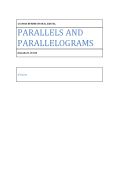IB Standard Level Maths: Portfolio Piece 1
Parallels and Parallelograms
Table of Results for 4 transversals:
→ Let n = number of transversals and let p = number of parallelograms
Use of Technology:
Using the TI – 84 Plus, press STAT → 1: Edit.
Type in L1, L2: (2, 1)
(3, 3)
(4, 6)
…etc.
Using Quadreg, L1, L2, rule → y = 0.5 x 2 - 0.5 x + 0
= ½ x2 – ½ x
= (x2 – x) ÷ 2

→ If n is the number of transversals and p is the number of parallelograms, then the rule is:
General statement:
If there are n transversals and two horizontal lines, then p = sum of all integers from 1 to (n – 1)
Test of Validity for n = 10
→ e.g. 1) 10 transversals, 2 horizontal lines
- A1,
- A2,
- A3,
- A4,
- A5,
- A6,
- A7,
- A8, ...
This is a preview of the whole essay
→ If n is the number of transversals and p is the number of parallelograms, then the rule is:
General statement:
If there are n transversals and two horizontal lines, then p = sum of all integers from 1 to (n – 1)
Test of Validity for n = 10
→ e.g. 1) 10 transversals, 2 horizontal lines
- A1,
- A2,
- A3,
- A4,
- A5,
- A6,
- A7,
- A8,
- A9
= 9
- A1 ∪ A2,
- A2 ∪ A3,
- A3 ∪ A4,
- A4 ∪ A5,
- A5 ∪A6,
- A6 ∪A7,
- A7 ∪A8,
- A8 ∪A9
= 8
- A1 ∪ A2 ∪ A3,
- A2 ∪ A3 ∪ A4,
- A3 ∪ A4 ∪ A5,
- A4 ∪A5 ∪A6,
- A5 ∪A6 ∪A7,
- A6 ∪A7 ∪A8,
- A7 ∪A8 ∪A9
= 7
- A1 ∪ A2 ∪ A3 ∪ A4,
- A2 ∪ A3 ∪ A4 ∪ A5,
- A3 ∪ A4 ∪ A5 ∪ A6,
- A4 ∪ A5 ∪ A6 ∪ A7,
- A5 ∪ A6 ∪ A7 ∪ A8,
- A6 ∪ A7 ∪ A8 ∪ A9
= 6
- A1 ∪ A2 ∪ A3 ∪ A4 ∪ A5,
- A2 ∪ A3 ∪ A4 ∪ A5 ∪ A6,
- A3 ∪ A4 ∪ A5 ∪ A6 ∪ A7,
- A4 ∪ A5 ∪ A6 ∪ A7 ∪ A8,
- A5 ∪ A6 ∪ A7 ∪ A8 ∪ A9
= 5
- A1 ∪ A2 ∪ A3 ∪ A4 ∪ A5 ∪ A6,
- A2 ∪ A3 ∪ A4 ∪ A5 ∪ A6 ∪ A7,
- A3 ∪ A4 ∪ A5 ∪ A6 ∪ A7 ∪ A8,
- A4 ∪ A5 ∪ A6 ∪ A7 ∪ A8 ∪ A9
= 4
- A1 ∪ A2 ∪ A3 ∪ A4 ∪ A5 ∪ A6 ∪A7,
- A2 ∪ A3 ∪ A4 ∪ A5 ∪ A6 ∪ A7 ∪A8,
- A3 ∪ A4 ∪ A5 ∪ A6 ∪ A7 ∪ A8 ∪A9
= 3
- A1 ∪ A2 ∪ A3 ∪ A4 ∪ A5 ∪ A6 ∪A7 ∪A8,
- A2 ∪ A3 ∪ A4 ∪ A5 ∪ A6 ∪ A7 ∪A8 ∪A9
= 2
- ∪ A2 ∪ A3 ∪ A4 ∪ A5 ∪ A6 ∪A7 ∪A8 ∪A9
= 1
➔ 45
p = sum of all integers from 1 to (10 – 1)
= sum of all integers from 1 to 9
= 1 + 2 + 3 + 4 + 5 + 6 + 7 + 8 + 9
= 45
p = (n2 – n) ÷ 2
p = 102 – 10 ÷ 2
= 90 ÷ 2
= 45
→ Let m = number of horizontal lines
If there are three horizontal lines, intersecting two transversals (m = 3, n = 2) then p = 3. Similarly, if there are three transversals, and two horizontal lines, (m = 2, n = 3), then we also obtain p = 3.
Conclusion:
Hence, m horizontal lines and n transversals produce the same amount of parallelograms as n horizontal lines and m transversals.
General Statement:
If there are m horizontal lines, and two transversals, then p = sum of all integers from 1 to (m – 1). Note that this rule is identical to the above investigation of n transversals and two horizontal lines.
Test of Validity for m = 10, n = 2
We will now prove that if m = 10, where n = 2, we will get the same p value of 45 as example 1 above where m = 2 and n = 10.
→ e.g. 2) 10 horizontal lines, 2 transversals
Manual method:
- A1,
- A2,
- A3,
- A4,
- A5,
- A6,
- A7,
- A8,
- A9
= 9
- A1 ∪ A2,
- A2 ∪ A3,
- A3 ∪ A4,
- A4 ∪ A5,
- A5 ∪A6,
- A6 ∪A7,
- A7 ∪A8,
- A8 ∪A9
= 8
- A1 ∪ A2 ∪ A3,
- A2 ∪ A3 ∪ A4,
- A3 ∪ A4 ∪ A5,
- A4 ∪ A5 ∪ A6,
- A5 ∪ A6 ∪ A7,
- A6 ∪ A7 ∪ A8,
- A7 ∪ A8 ∪ A9,
= 7
- A1 ∪ A2 ∪ A3 ∪ A4,
- A2 ∪ A3 ∪ A4 ∪ A5,
- A3 ∪ A4 ∪ A5 ∪ A6,
- A4 ∪ A5 ∪ A6 ∪ A7,
- A5 ∪ A6 ∪ A7 ∪ A8,
- A6 ∪ A7 ∪ A8 ∪ A9
= 6
- A1 ∪ A2 ∪ A3 ∪ A4 ∪ A5,
- A2 ∪ A3 ∪ A4 ∪ A5 ∪ A6,
- A3 ∪ A4 ∪ A5 ∪ A6 ∪ A7,
- A4 ∪ A5 ∪ A6 ∪ A7 ∪ A8,
- A5 ∪ A6 ∪ A7 ∪ A8 ∪ A9
= 5
- A1 ∪ A2 ∪ A3 ∪ A4 ∪ A5 ∪ A6,
- A2 ∪ A3 ∪ A4 ∪ A5 ∪ A6 ∪ A7,
- A3 ∪ A4 ∪ A5 ∪ A6 ∪ A7 ∪ A8,
- A4 ∪ A5 ∪ A6 ∪ A7 ∪ A8 ∪ A9
= 4
- A1 ∪ A2 ∪ A3 ∪ A4 ∪ A5 ∪ A6 ∪A7,
- A2 ∪ A3 ∪ A4 ∪ A5 ∪ A6 ∪ A7 ∪A8,
- A3 ∪ A4 ∪ A5 ∪ A6 ∪ A7 ∪ A8 ∪A9
= 3
- A1 ∪ A2 ∪ A3 ∪ A4 ∪ A5 ∪ A6 ∪A7 ∪A8,
- A2 ∪ A3 ∪ A4 ∪ A5 ∪ A6 ∪ A7 ∪A8 ∪A9
= 2
- ∪ A2 ∪ A3 ∪ A4 ∪ A5 ∪ A6 ∪A7 ∪A8 ∪A9
= 1
➔ sum of all parallelograms: 45
Using equation:
p = sum of all integers from 1 to (10 – 1)
= sum of all integers from 1 to 9
= 1 + 2 + 3 + 4 + 5 + 6 + 7 + 8 + 9
= 45
p = (m2 – m) ÷ 2
p = 102 – 10 ÷ 2
= 90 ÷ 2
= 45
We now investigate p for m horizontal lines and n transversals where m, n > 2.
→ Consider the diagram below where m = 3 and n = 4.
- A1,
- A2,
- A3,
- A4,
- A5,
- A6
= 6
- A1 ∪ A2,
- A2 ∪ A3,
- A4 ∪ A5,
- A5 ∪A6,
- A1 ∪A4,
- A2 ∪A5,
- A3 ∪A6
= 7
- A1 ∪ A2 ∪ A3,
- A4 ∪ A5 ∪ A6,
= 2
- A1 ∪ A2 ∪ A4 ∪ A5,
- A2 ∪ A3 ∪A5 ∪ A6
= 2
- A1 ∪ A2 ∪ A3 ∪ A4 ∪ A5 ∪ A6
= 1
→ p = 6 + 7 + 2 + 2 + 1
= 18
From the earlier conclusion, p will also equal 18 if m = 4 and n = 3.
Now refer to the table of p values below.
Table of p values for different values of m and n
m = parallel lines
→ The results below are processed data from Microsoft Excel.
etc.
From the table, if m = 2 and n = 5, then p = 10. Also, if m = 4 and n = 2, then p = 6. The table also shows that if m = 4 and n = 5, then p = 10 x 6. (= 60)
General statement:
It appears that for any diagram with m horizontal lines, and n transversals, the resultant value of p equals the product of p1 and p2, where;
p1 = number of parallelograms for m horizontal lines and two transversals
p2 = number of parallelograms for 2 horizontal lines and n transversals.
Hence, for any diagram with m horizontal lines and n transversals,
Test of validity for m = 4, n = 3
- A1,
- A2,
- A3,
- A4,
- A5,
- A6
= 6
- A1 ∪ A2,
- A2 ∪ A3,
- A4 ∪ A5,
- A5 ∪A6,
- A1 ∪A4,
- A2 ∪A5,
- A3 ∪A6
= 7
- A1 ∪ A2 ∪ A3,
- A4 ∪A5 ∪A6
= 2
- A1 ∪ A2 ∪ A4 ∪ A5,
- A2 ∪ A3 ∪A5 ∪ A6
= 2
- A1 ∪ A2 ∪ A3 ∪ A4 ∪ A5 ∪ A6
= 1
→ p = 6 + 7 + 2 + 2 + 1
= 18
→ p = ½ m (m – 1) x ½ n (n – 1)
= ½ 4 (4 – 1) x ½ 3 (3 – 1)
= 6 x 3
= 18
Scope/limitations:
The formula will be valid for m, n ≥ 2. If either value were to be 1 or 0, it would be impossible to create any parallelograms.
Explanation of generalisation:
A diagram with m horizontal lines and 2 transversals creates p1 parallelograms.
A diagram with 2 horizontal lines and n transversals creates p2 parallelograms.
It follows that if a diagram were created, with m horizontal lines, and n transversals, we would be able to fit p1 parallelograms vertically and p2 parallelograms horizontally, giving us a total of p1 x p2 parallelograms.






